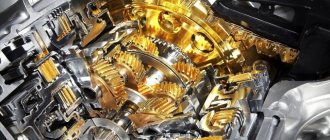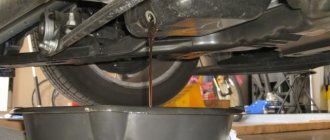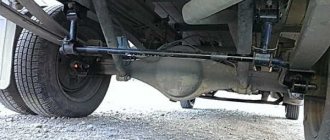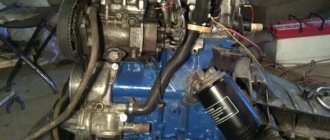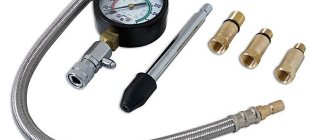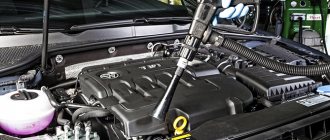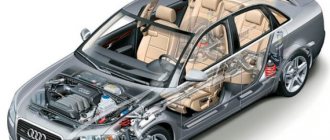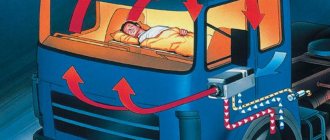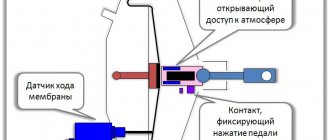How to find out engine size: online, by VIN code
The displacement of a car's engine is the sum of the working volumes of its cylinders.
The units of measurement are both cubic centimeters (cm3) and liters (l.) (1 liter is equal to 1000 cubic centimeters): 1l=1000cm³
When the value must be indicated in liters, when converting units of measurement, rounding is done to a whole number after the decimal point, for example, if the value is 1598 cubic centimeters, the liters will be 1.6 liters, and, for example, the volume of 2429 cubic centimeters will be 2. 4 liters.
The vehicle's power, fuel consumption and other operating parameters directly depend on the engine displacement.
There are several ways to find out engine size:
- This characteristic is indicated in the technical passport of the vehicle. There are “craftsmen” who like to advise unscrewing all the spark plugs and pouring water into the cylinders “to capacity”. The volume of water placed in them, according to them, should be the same as that of the engine. This method should not be used, as it is just an old joke.
Click on photo to enlarge
- If you buy a used car, the numbers indicated in its registration certificate may not be entirely correct. It is possible that the car was involved in an accident or perhaps some work was carried out on it that affected the engine's performance. What if it was actually assembled from several cars? The actual volume, in these cases, can be found out by looking at the numbers on the cylinder block. This is the value of the working volume. They are indicated at the back with large symbols (you can see them from the pit).
- And of course, according to the VIN code.
- How to find out engine size by VIN code? Decoding the VIN code
- How to decipher VIN code online?
How to find out engine size by VIN code? Decoding the VIN code
You can also find out the engine size by the VIN code. You can see it at the bottom of the driver's door arch, naturally, after opening it first. It is also indicated under the rear seat, under the windshield and in the upper left part of the instrument panel (in this case, the code must be looked at from outside the car).
The last method listed is the most reliable. Since the VIN code is indicated on all cars that were produced starting from about 1980. It consists of seventeen characters, among which the Latin letters I, O and Q are not used due to their similarity with the numbers 1 and 0.
- The first three characters indicate the car manufacturer's index. (The first is the geographic area code, the second is the country code in that geographic area, and the third is the manufacturer's symbol).
- The fourth to eighth digits inform about the main technical parameters of the car: model, engine type and size, body type, and so on.
- The ninth character is the check digit. It is needed so that the authenticity of the VIN code can be determined. With its help, you can find out whether the car is listed as stolen.
- The twelfth to seventeenth characters are the car body number.
How to find out the horsepower of a car
In the documents for the car, this information is given in kW. To convert the specified unit of measurement to horsepower, you need to multiply the digital value in kW by 1.35. To convert horsepower to kW, its value is multiplied by 0.735.
Usually the value indicated in the documents corresponds to reality. If in doubt, it is possible to measure the amount of horsepower yourself. Formulas designed to calculate the power of a car based on various factors cannot give a 100% correct answer, but they allow you to calculate the average value.
The power of the car can be found at the service station. To do this, just test it on a dyno.
How to calculate power through torque
The easiest way to determine engine power is by calculating through torque. You need to multiply the digital value of torque (μr) by the number of crankshaft revolutions per minute (n). To get the value of n exactly in revolutions per minute, and not in alpha cosines, it is divided by 9549.
Power=Mkr • n/9549
The resulting figure is the power value in kW.
Such a calculation shows the effective power without taking into account losses due to resistance, transmission, gearbox and associated energy consumers.
How to calculate power by engine volume
If the torque value is not known, the power can be calculated using the following data:
- engine volume in cubic centimeters (Vh);
- number of crankshaft revolutions per minute (n);
- mean effective pressure (pe).
The engine displacement is multiplied by the average pressure and the number of revolutions per minute divided by 120.
Power=Vh • pe • n/120
We get the result in kW and convert it to horsepower.
Average effective pressure
| Motor type | Average value, MPa |
| Gasoline regular | 0,82-0,85 |
| Gasoline boosted | 0,9 |
| Diesel | 0,9-2,5 |
Calculation of engine power based on air flow
A similar calculation is available for owners of a car equipped with an on-board computer. It allows you to record air flow. To do this, data is taken at the moment when the car produces 5.5 thousand revolutions, being in third gear. It is enough to divide the resulting figure by three. There is no need to carry out additional calculations, since the result is already in horsepower.
In this way, the power value is obtained without taking into account inevitable losses. Actual power during operation is 10-15% lower.
Calculation of power by weight and acceleration time to 100 km/h
For calculations, the numerical value of the vehicle's mass in kilograms and the acceleration time to 100 km/h are used. The weight of the vehicle is indicated taking into account the weight of the driver. To calculate horsepower, you need to divide the mass of the car by the acceleration time.
Reference! When calculating, the approximate loss of time due to slipping should be taken into account. On average this is 0.3-0.5 seconds.
How to check engine size
by Steve Gregory
Shane Stillings/Demand Media
The size of a car's engine is an important factor in its overall evaluation. For example, insurance companies use engine size to help determine the cost of car insurance premiums, while banks use it as a factor in determining the cost of a car loan. If you want to know your car's engine size, there are several ways to get the information.
Step 1
Open the hood of your car and let it in. Make sure it is turned off and cold before proceeding. Inspect the engine compartment for an etched or raised mark indicating engine size. Some cars have an EPA sticker under the hood that lists average gas consumption as well as engine size.
How to Determine Vehicle Engine Size
by Contributing Writer Updated June 12, 2021
The size of the engine running on the vehicles may also be specified. Decrypting your vehicle is a simple process that usually requires a phone call to your local dealership. There are also several vehicle decoder sites on the Internet. However, the most reliable way to determine engine size is a quick call to a professional vehicle dealership.
How to determine engine size by VIN
Locate the 17-digit VIN on your vehicle. The most common areas for the VIN are on the dashboard near the base of the windshield, inside the glove compartment, or on the inside door frame.
Write down the 17-digit code.
Call your local dealership for your vehicle's make and ask to speak with a representative who can help you decipher the VIN.
Read your VIN to the dealer and ask him to decipher the engine size for your vehicle.
How to Determine Engine Size for a 1977 Ford F-150
engine size Locate the "Vehicle Certification Plate" on the driver's door pillar. Open the driver's door and look where the door latch, it is directly above the latch where the door closes. On the cabin, not on the door.
Write the number in the upper right corner of the label. It is 11 characters long and will look something like this: "F25HLDC0000".
Notice the fourth character, which will be a letter. It stands for as follows: “B” -300 cubic inches inline-six; "G" -302 cubic inch V-8; "H" -351 cc. Inch V-8; "M" - 390 cubic inch V-8; "S" -400 cubic inch V-8; "J" is a 460 cubic inch V-8. In the example above "F25HLDC0000" the "H" is the engine code indicating a 351 cubic inch V-8.
How to Determine Ford Ranger Engine Size
Open the hood and locate the emissions sticker on the top radiator support. The engine family is indicated in small print in a box in the lower right corner of the sticker. It is not labeled as such, but can be identified by the use of a standard engine format - "2.3L", "4.0L", etc.
Locate the 17-digit VIN under the windshield on the driver's side of the dash. Write down the VIN and use a VIN decoder website, such as the one in the Resources section of this article, to determine your specific engine size. Alternatively, you can write down the 8th digit of the VIN, which is the engine code, and decode that digit based on your year and model.
Look in your owner's manual or refer to the online manual for your year and model and look in the "Engine Compartment Component Identification" section. By comparing the pictures in the manual to the location of the components in the engine bay, you can identify the engine in your Ranger.
Differences in marking of BMW N series engines
The marking of BMW N-series engines indicates a letter indicating the power class of the unit. So, for the N52B30T1 , the letter T means the highest power class (top version).
This last digit can have a value from 1 to 9, depending on the restyling version. So, our N52B30T1 engine has not undergone any changes.
How to Determine VW Engine Size
Volkswagen engines, for 40 years, have had air-cooled, horizontally opposed four-cylinder powerplants. From 1938 to 1980, the VW Beetle carried this engine style; while it may look like a newcomer, some key features show an evolution in size and horsepower. Other models shared the Beetle for their respective year, such as the Type 2 (transporter/bus) and Type 3 (station wagon). All were rear-wheel drive, rear-wheel drive vehicles.
Step 1
Find out what year the Volkswagen model is. Although this is not always certain, since these engines are known for being easy to replace, if the engine came with the vehicle, then the year of the vehicle will determine the size of the engine. Only a certain size was produced in a certain year. For example, in 1978, a 2000 cc engine was manufactured. See for Beetle and Transporter. For most VWs, the year can be found on the door jamb sticker, if applicable.
Step 2
Examine the engine code located on the rear top of the engine. In most cases, this code determines the size of the engine and when it was manufactured. Often the first few letters or numbers give the year of manufacture.
Step 3
Visually inspect the engine. Throughout the Beetle's life, the engine was constantly enlarged and became more powerful. In the 1960s it was powered by an anemic 1200 cc engine, which was decidedly smaller and had no fans or heaters. In 1966, only the 1300 cc engine was available. CM, which resembled the 1200. Several additions were made in 1967, including a much larger 1500 cc engine. CM, which visually took up much more space in the engine compartment than older models. It also had a larger generator and larger belt pulleys. With the introduction of the 1976 model, the 2000 cc engine. CM has become the standard. This is the most recognizable engine, featuring a large flat design and grill inserts in front of the main belt pulley.
Volkswagen engines after 1982 differ significantly from their air-cooled predecessors. While the Beetle arrived on the American market in 1980, the Transporter, now called the Vanagon, continued to use a 2000 cc air-cooled engine. See pre-1983. After this year, VW made the final switch to water-cooled engines, and engine sizes for most of the production line became model specific.
Source
How to determine car engine size
As you know, engine displacement is directly associated with power and speed for many car enthusiasts. In practice, this often happens, because if we are talking about passenger cars, and not about special equipment, then the larger the engine volume, the faster, more powerful and more dynamic the vehicle turns out to be.
Note that the only exception to this unspoken rule can be considered units with a mechanical compressor or turbocharging, where the displacement may be relatively small, but the power of such an engine is quite high compared to atmospheric counterparts.
For this reason, some owners have a desire to find out the real volume of the power unit. This may be necessary to calculate some taxes on vehicle maintenance, etc. Next, we will try to answer the question of how to determine engine size.
What does engine size affect?
Engine ZMZ-406: description and technical characteristics.
gazelle 405 engine size Firstly, gasoline consumption. The larger the cylinder volume, the more fuel is needed to ignite it with maximum efficiency, and accordingly, consumption increases. However, this minus turns into an equally tangible plus. The larger the engine displacement, the greater the engine power, since more gasoline releases more energy.
Secondly, as already noted, the larger the volume, the greater the power, that is, a car with a larger engine will accelerate faster, be able to carry heavier loads and more passengers. Often, larger engines turn out to be much more economical: there is no need to press the gas pedal hard to accelerate the car. Fuel consumption does not increase, while small engines burn much more fuel under load. The larger the volume, the larger the engine itself, the larger the car. Let's put it this way: large volumes are used on higher-class cars, which is why the engine and all other systems are more expensive to maintain. The price for such a car is obviously higher. In order to understand which car is best for you, you should understand that micro and small cars are best suited for driving in large cities with traffic jams. Their consumption in city traffic will be minimal compared to other cars, but, in turn, such cars are not suitable for long journeys, since at speeds over 100 km/h they clearly do not have enough power. They will also not be able to transport a lot of cargo.
Cars with a volume of 1.8 to 3 liters are excellent for both city traffic and long trips; their power is enough for acceleration and driving at high speed, for transporting goods, and the gas mileage of such cars is not that great.
Cars equipped with engines of 3 liters or more are either SUVs or minibuses and minivans designed to carry more passengers or cargo.
Sources
- https://krutimotor.ru/na-chto-vliyaet-obem-dvigatelya/https://v-mireauto.ru/chto-takoe-obem-dvigatelya-avtomobilya/https://znanieavto.ru/dvs/rabochij- obem-dvigatelya.htmlhttps://www.mnogo-otvetov.ru/avto/chto-takoe-obem-dvigatelya-i-na-chto-on-vliyaet/
Engine size: how to find out
First of all, this characteristic can be determined by studying the technical passport of the vehicle. To determine this, you can also use the vehicle’s VIN code, which is actually a unique vehicle identification number and contains a lot of useful information about the vehicle’s configuration, country of manufacture, etc.
The vehicle's VIN code can be located in different places, on the pillar between the driver's and passenger's rear doors on a special plate, closer to the wheel arch, under the rear seat, on the dashboard closer to the windshield, under the hood in the engine shield area, etc.
To obtain accurate information, you need to find the engine number, as well as other designations on the internal combustion engine. Based on the data obtained, you can then find this motor in the manufacturer’s catalogs and find out its displacement, as well as other characteristics. Please note that the engine number is not always easy to find.
How to determine engine cylinder volume
So, in order to find out the volume of an engine cylinder, you should understand that the cylinder is actually a container, like cylindrical household objects (cup, jar, etc.). Knowing the radius and height, the volume is calculated quite easily. If these parameters are not specified, then the task becomes more complicated. You also need to take into account the fact that an internal combustion engine cylinder is not always ideal in circumference.
Let's get back to the measurements. To calculate the volume, you need to multiply the height by the number "Pi" and the square of the radius (Volume is equal to B multiplied by π and multiplied by P². The letter B in this formula is the height of the cylinder, P represents the radius of the base, and the number π is approximately equal to 3.14.
It is important to understand that this formula is suitable for measuring the volume of a right circular cylinder, that is, the base is a circle, and the guide is strictly perpendicular to it.
By the way, if instead of the radius of the cylinder in the initial data there is a diameter, then calculations should be made according to the formula, where the volume is equal to B multiplied by π and multiplied by (D/2)². Another formula for calculations is the following: Volume is equal to ¼ times B times π times D². In this case, D is the diameter of the base of the cylinder.
As for practical measurements, it is somewhat easier to measure the perimeter, that is, the circumference of the base of the cylinder, than to measure the diameter or radius. It turns out that you can calculate the volume, if the perimeter of the base of the cylinder is known, using the formula where the volume is equal to ¼ times B times P² / π. The letter P is the perimeter of the base. You also need to take into account that when making calculations, the actual capacity will be slightly less than what the calculations show, since the volume of the vessel walls is not taken into account.
How to learn to read BMW engine codes and markings
BMW engines are marked with letters and numbers. By analogy with the VIN code, this is how the manufacturer encrypts important data. Learn to “identify” the engine of your BMW using this code - you will become an expert. And it will be easier to find spare parts, if something happens.
Let's see what the decoding of the engine labeled M52B25TU tells us.
Let's start with the letter M. It denotes the family (series, generation) of BMW engines.
So, the owner may encounter the following options:
There are also engines of the P and S series - these are BMW racing engines intended for serial production (S family) or not (P series).
Under the letter W are motors that are supplied to the Bavarians by third-party developers.
Next in our example is the number - 52 . The first number, 5, indicates the number of cylinders in the engine. There are options:
The number 2 in our example means that the original basic engine design has been modified. At the same time, both a basic and a modified version can be produced simultaneously, that is, modification of a BMW engine does not mean its automatic replacement.
So, in our example, the M52 engine is gasoline, and the M51 is diesel, but both of them are a modified design of the M50.
Therefore, the second number “0” will mean the original design of the motor, and numbers from 1 to 9 in the motor marking indicate all subsequent changes to the model.
After the engine model (M52) there is additional data. So, the letter B in our example M52B25TU will indicate the type of fuel (gasoline) and how the engine is installed (longitudinal). There are options:
